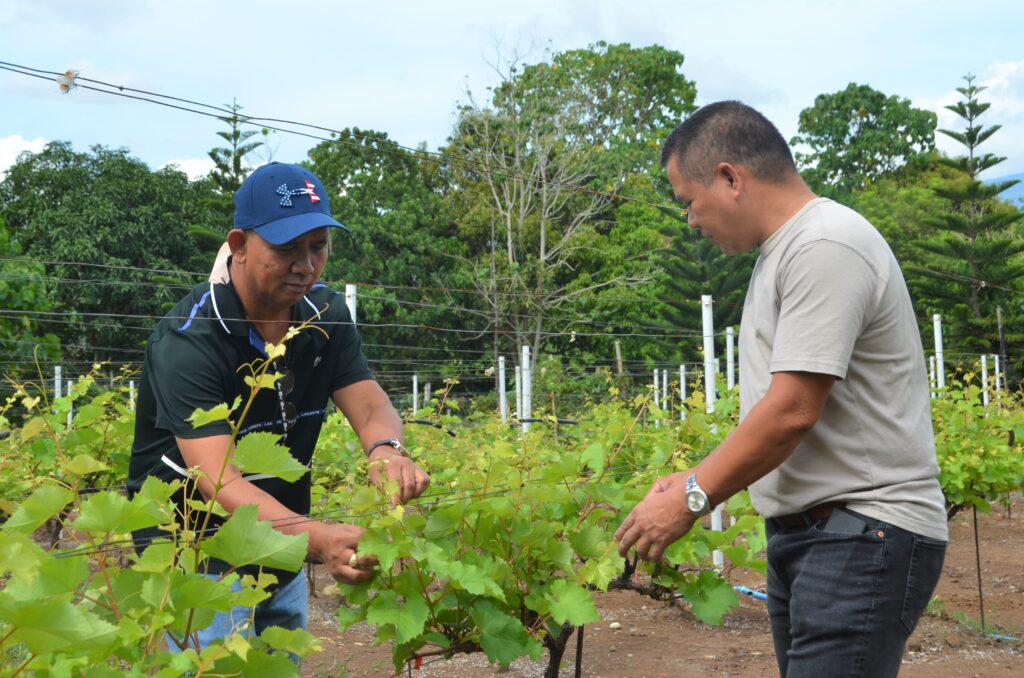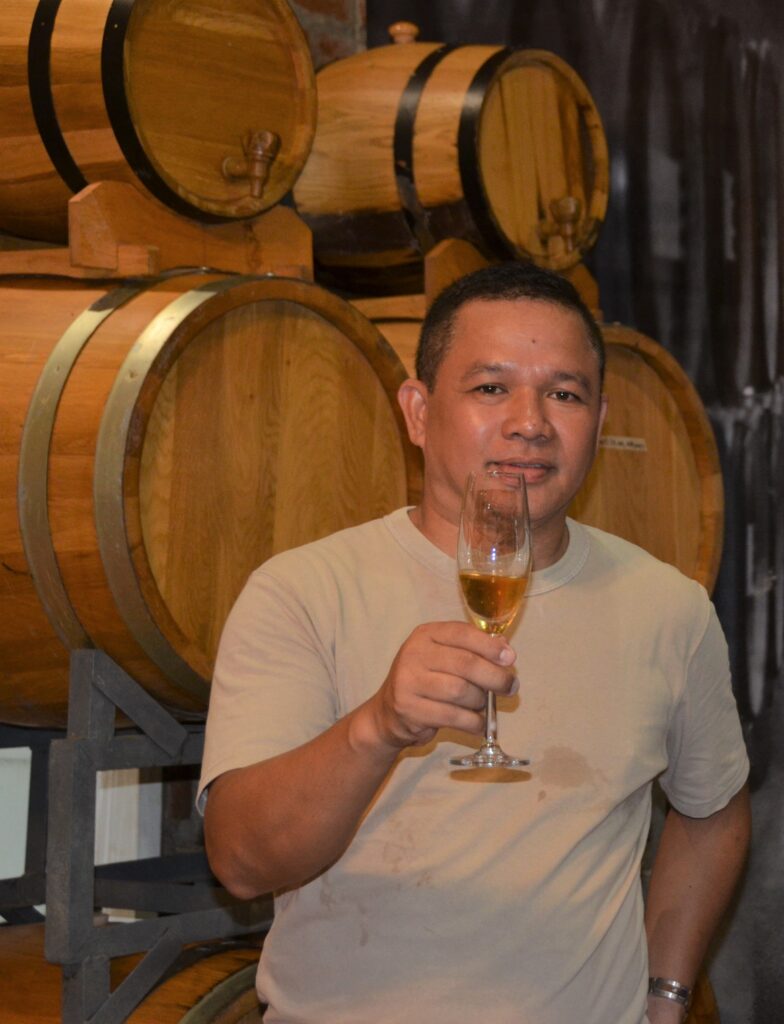Text and Photos by Henrylito D. Tacio
Grapes are excellent sources of manganese and good sources of vitamin B6, thiamin (vitamin B1), potassium, and vitamin C. In addition, grapes contain flavonoids: phytochemicals that have antioxidant compounds.
They are available only during special occasions like Christmas and New Year. It is also served during events like weddings, birthdays, and other parties. Most of these grapes are imported.
Most Filipinos think grapes grow well only in Europe, the United States, Australia, and China. But what they don’t know is that the country’s warm weather is much better for growing the crop.
In those temperate countries, grapes can be harvested only once in a year. But in the Philippines, harvesting can be done twice. Or even thrice, although third harvesting is not encouraged.
The country’s climate and weather are best suited for growing grapes but Filipino farmers are not very keen on grapes. It may be because they believe grapes will not prosper in the Philippines.
This thinking is now changing. In fact, more and more grape farms are being established knowing that the Philippines is best suited for grape growing. You can now find vineyards in La Union, Masbate, Nueva Ecija, Cebu, Iloilo, Cotabato, General Santos City, and Davao.
Yes, there’s already a vineyard in Davao City. It is located in barangay Tacunan in Tugbok District. Atty. Ferdinand Taglucop, who is also an agricultural engineering graduate, started growing grapes as a hobby eight years ago. He planted mostly seedless table grapes and wine varieties in his 3.5-hectare farm.
There are more than a thousand types of grapes. There are those that are eaten from the vine (table grapes) or grown to make into wine (viniculture) or used to make dried fruit (raisin grapes). Size, taste and physical characteristics differ amongst the varieties. They come in a variety of colors including green, amber, red, blue-black, pink, yellow, and purple.
After three years of planting grapes, Atty. Taglucop found out that not all grapes are created equal. Some varieties could not be eaten as they were sour. There were sweet varieties but the fruits they produced were few and in-between. Others were attacked by pests and diseases.
All these were the reasons, he believed, why most of those who planted grapes didn’t prosper and discontinued what they had started.
Despite all these obstacles, he persisted. He studied the right ways to grow grapes through readings on the internet. Every time he and his wife Jenny went out of the country, he sourced some seeds and cuttings. He experimented with various varieties of grapes – from temperate to semi-temperate countries.
Atty. Taglucop planted them – about 60 varieties all in all – in his farm. Not all of those he planted thrived well. One by one, he eliminated those varieties which don’t grow well, don’t produce enough fruits, or whose fruits are sour. Varieties that could not survive the tropical climate were also discarded along with those susceptible to pests and diseases.
Growing grapes is easy in theory. But in reality, it is difficult. In fact, after eight years, he still keeps on experimenting. According to him, he plants the seedlings at around one-foot deep. “The roots of full-grown vines can go as deep as 15 feet although most of the roots grow up in the top three feet of soil,” he said.
Since grapes are creeping plants (vines), they have to be provided with trellis. For him, the easiest and most economical trellis to construct and maintain is vertical shoot positioning (VSP) with four wires, 8 feet above the ground and is well anchored on each end. In the VSP system, the vine shoots are trained upward in a vertical, narrow curtain with the fruiting zone below.
From planting up to around one year and before the first pruning to make the vines bear fruits, he fertilizes his grape vines with complete fertilizer (14-14-14) and calcium nitrate plus supplementary micronutrients. Fertilization, a necessity in grape growing, is done every month.
Atty. Taglucop also broadcasts chicken dung and/or vermicast once every six months. “During pruning and fruiting, we fertilize them according to the specific needs of the vines during its phenological stage,” he said. “It is advisable to take a leaf, petiole or at least soil sample to optimize inputs.”
Like most crops, grapes need water. If there is no rain for a week, he irrigates the crop twice. “But considering that we always have rain events at least twice a week, we don’t irrigate our grapes most of the time,” he said.
He harvests grapes twice a year. From his fully-grown mature vines, he is able to get 5-10 kilograms. “We have grape picking activity during harvest,” he said.
Grapevines must be pruned every year to remain fruitful. Depending on the weather, he prunes the grapes at least one month after harvesting. “We don’t want to prune during rainy days because of possible fungal/bacterial/viral infection on freshly cut canes,” he said. “Rain events are also not good during the flowering stage and harvesting season.”
The cuttings after pruning are used for seedling propagation. Cuttings from diseased or infected vines are discarded. “We cut the canes to 3-4 nodes, bundle them in 20s to 30s, soak them in water with small fungicide and chlorine to sanitize and bury them in river sand,” he said.
The cuttings are taken out from where they were buried out once they have already rooted. “That is the time we bag them separately,” he said, adding that the size of the bag is 6-8 inches by 12-14 inches.
Before they can be transplanted in the field, the seedlings are exposed to morning sunlight only within 20 days. “After that, they are exposed to 75% sunlight for the next two months or so. Then to full sunlight at least one month before they are transferred to the field,” he said.
Actually, Atty. Taglucop admitted that he started growing grapes as a hobby albeit with an eye on farm tourism. “But the big dream is really the winery because that’s the main thing in other countries,” he said.
After eight years of experimenting and trials, he found seven world renowned varieties of grapes that have good potential for production and making quality wines in his area. Not necessarily in the order, these are: Shiraz (from Australia), Moldova (from Ukraine), Chardonnay and Petite Syrah (from France), Freisa (from Italy), Moscato (from Israel), and Chenin Blanc (sourced from Gran Monte, Thailand). He also has this sweet and aromatic variety which he called Davao Delicious from a Muscat variety parentage.
Right now, The Vineyard Davao – as he calls the place – is not yet open to the public as he is still on the production stage to increase his inventory of bottled wines before the winery will open.
Atty. Taglucop is not keen on engaging solely in the business of “grapes picking” only. “It may not be economically viable since you harvest grapes only every six months,” he said. “In-between, what will you do since you don’t have any harvest? So, you don’t have business. You close the farm for business but you still have to spend to maintain the vineyard.”
In other countries, people who grow grapes have winery. So, they are open all the time because wine is available all year-round. People can visit the place even if the grapes are not bearing fruits because they can always have wine, he said.
Although it is not yet open to the public, some people already enjoyed tasting his wines straight from the barrels in his cellar through privately arranged wine tasting and food pairing events. The farm caters to a minimum of 10 persons per group. Interested groups must book first before coming or else they will be denied entry.
Atty. Taglucop is so serious with making wine from grapes that he decided to enroll in a post-graduate Certificate Course on Winemaking and Viticulture with the University of California-Davis Campus, the leading university supporting the vineyards and wineries in Napa Valley and beyond. After two years of study online and visiting the university several times, he finally received his certificate of completion.
“Wine making starts with harvesting the grapes at the optimum time: right brix (sweetness), right acidity and right flavor,” he said.
The harvested grapes are processed into wine within five hours from harvest to optimize flavors. “Only the full-ripe and undamaged grapes are processed into wine,” he said.
After the grapes are harvested, they are transported to its winery, sorted for quality grapes then crushed and destemmed.
For red wine, the crushed grapes (juice, skins, flesh and seeds) are fermented for two weeks. These are pressed afterwards and aged in barrels for six to 12 months. After that, they are filtered and bottled.
For white wine, the crushed grapes are immediately pressed, fermented without skins, seeds and pulps for two weeks or so. These are aged in stainless steel for at least six months and then filtered and bottled.
Right now, one of his dreams is to put up a restaurant, cellar doors/wine tasting rooms in the middle of his vineyard in Tacunan. “Guests and visitors can stroll, harvest grapes, do grape stomping, do wine-tasting and food pairing, dine, chill and experience vineyard feels without necessarily going out of the country,” he said. “Hopefully, this dream can be materialized soon.”
He can do so only if he has enough wine already. So far, he has about 20,000 bottles of wine available. “We intend to stockpile around 50,000 bottles before we open the winery to the public,” he said.
When asked what makes grape growing and wine making challenging, he replied: “Our weather remains the main challenge to grape growing and wine making. In a humid and rainy environment like ours, fungus thrives. If not properly dealt with, quality grapes will never be had; worse, the whole vineyard will possibly be wiped out.
“Furthermore, resources or information on grape growing and even proper education, technology and proper planting materials are not available here,” he added. “It is really challenging. So, we need to be resourceful.” – ###
Photo captions:
1 Atty. Ferdinand Taglucop explains why grapes should be pruned. (Tacio)
2 Grapes are usually used for making wine. (Tacio)
3 Purple variety of grapes (Courtesy of Davao Vineyard)




